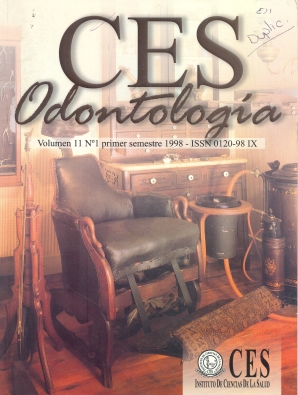ESTUDIO INVITRO COMPARATIVO DE LA RESISTENCIA A LA FRACTURA RADICULAR EN DIENTES INMADUROS Y OBTURADOS CON DOS CEMENTOS ENDODONTICOS
Resumen
Los pacientes con dientes inmaduros que sufren un trauma dentoalveolar el cual produce una necrosis pulpar, pueden terminar con paredes dentinales radiculares delgadas y ápices abiertos haciendo que sean más débiles para resistir un segundo trauma. El objetivo de este estudio, fue evaluar la resistencia a la fractura radicular de dientes inmaduros obturados con gutapercha y cemento de Grossman comparados con dientes obturados con cemento de ionómero de vidrio (Ketac - Endo) y un cono único de gutapercha # 45. Se tomaron 40 dientes inmaduros (bicúspides inferiores) de pacientes entre los 8 y 10 años de edad y se almacenaron en solución salina a temperatura ambiente. Los dientes fueron instrumentados con técnica circunferencial convencional, hasta una lima maestra apical 80 y fueron divididos en dos grupos, como se explicó anteriormente. Todos los dientes fueron sometidos a una fuerza en la raíz, en sentido bucolingual, perpendicular al eje longitudinal del diente a 3 mm de la unión cemento amélica, hasta producir la fractura. Se midió el área transversal del diente y con estos datos se obtuvo la resistencia a la fractura. Los resultados se evaluarán por medio de una prueba T de student. Se demostró que aunque es mayor el promedio de la resistencia a la fractura en el grupo de dientes obturado con ionómero de vidrio Ketac Endo, no es la diferencia estadísticamente significativa. ABSTRACT Dental impact injuries often result in pulp necrosis of young permanent teeth, incomplete development of dentinal walls and open apices. The purpose of this study was to evaluate the resistance to fracture of teeth with open apices, filled with lateral condensation tecnique (gutta-percha and Grossman sealer cement) compared with teeth with glass ionomer cement (Ketac - Endo) and one master cone # 45. Forty teeth were used (lower premolars) from patients between 8 to 10 years, stored in physiologic saline solution at room temperature. Each root canal was cleaned and shaped 1 mm short of the actual rooth canallenght, and prepared with the circumferential conventional technique up to size #80. And afterwords were divided into the two groups, mentioned above. In the Instron machine, the roots were subjected to a perpendicular force to the long axis until fracture, the transversal area was measured manually and the resistance to fracture obtained. The results between the two groups were compared. The data was subjected to a T Student analysis. The group filled with glass ionomer cement and one master cone #45, showed a higher resistance to fracture but it was not statistic any significant from the first group.Descargas
Los datos de descargas todavía no están disponibles.
Descargas
Publicado
2009-11-18
Cómo citar
1.
Angel Morales N, González Villa CL, Naranjo M. ESTUDIO INVITRO COMPARATIVO DE LA RESISTENCIA A LA FRACTURA RADICULAR EN DIENTES INMADUROS Y OBTURADOS CON DOS CEMENTOS ENDODONTICOS. CES odontol. [Internet]. 18 de noviembre de 2009 [citado 6 de agosto de 2024];11(1):9-15. Disponible en: https://revistas.ces.edu.co/index.php/odontologia/article/view/835
Número
Sección
Artículo de Investigación Científica y Tecnológica
| Estadísticas de artículo | |
|---|---|
| Vistas de resúmenes | |
| Vistas de PDF | |
| Descargas de PDF | |
| Vistas de HTML | |
| Otras vistas | |



